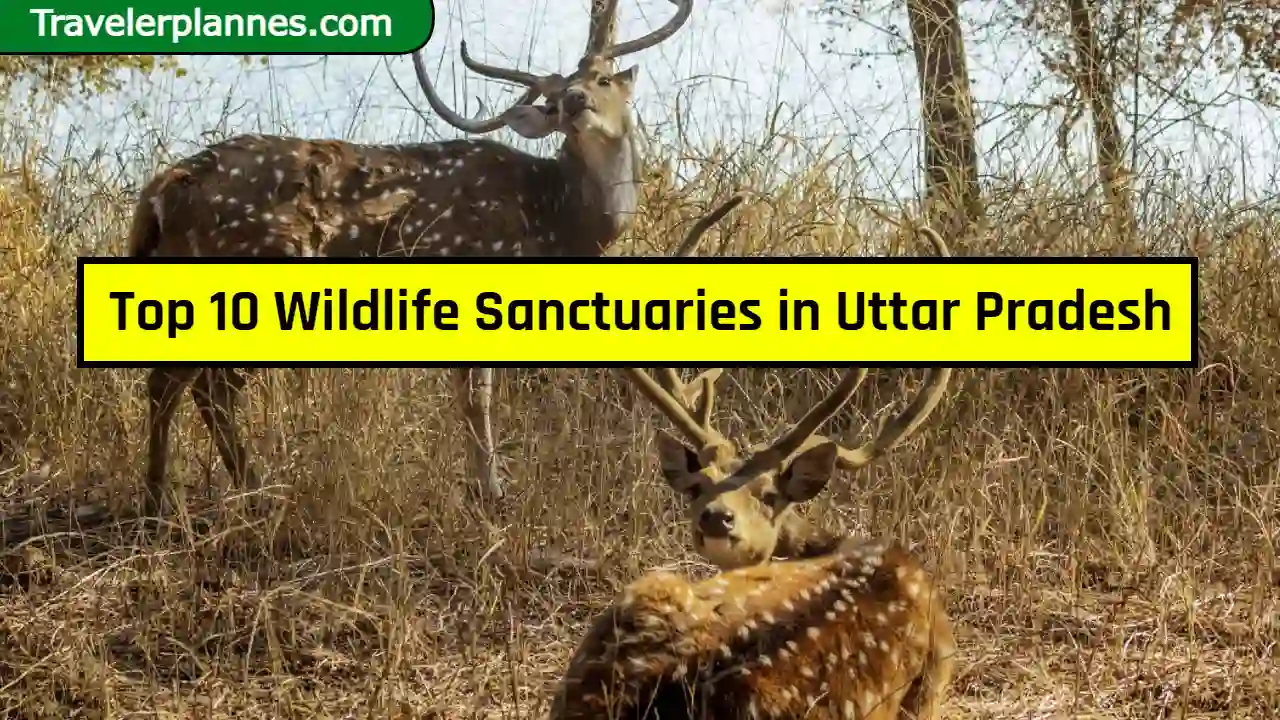Uttar Pradesh, often celebrated for its rich historical and cultural heritage, is also home to a diverse range of wildlife sanctuaries that offer a glimpse into the natural wonders of this northern Indian state. From the dense forests of Dudhwa to the tranquil wetlands of Saman, Uttar Pradesh’s wildlife sanctuaries provide a haven for a wide variety of flora and fauna.
In this comprehensive guide, we’ll take you on a journey through the top 10 wildlife sanctuaries in Uttar Pradesh, showcasing their unique features, resident species, and the best ways to experience their natural beauty.
Contents
- 1 1. Dudhwa National Park
- 2 2. Katarniaghat Wildlife Sanctuary
- 3 3. Saman Wildlife Sanctuary
- 4 4. Chandra Prabha Wildlife Sanctuary
- 5 5. Kishanpur Wildlife Sanctuary
- 6 6. Nawabganj Bird Sanctuary
- 7 7. Samaspur Bird Sanctuary
- 8 8. Mahavir Swami Wildlife Sanctuary
- 9 9. Ranipur Wildlife Sanctuary
- 10 10. Kachhua Sanctuary
- 11 Conclusion
1. Dudhwa National Park
Location: Lakhimpur Kheri District
Why Visit Dudhwa National Park:
Dudhwa National Park, nestled in the Terai region of Uttar Pradesh, is a paradise for wildlife enthusiasts. This park is known for its thriving population of the Bengal tiger, Indian rhinoceros, and the elusive swamp deer, also known as the barasingha. Exploring Dudhwa offers opportunities for wildlife safaris, birdwatching, and experiencing the vibrant biodiversity of the Terai ecosystem.
Dudhwa National Park covers an area of approximately 490 square kilometers and is part of the Dudhwa Tiger Reserve. The park’s landscape comprises dense sal forests, grasslands, and marshes, creating a diverse habitat for a wide range of wildlife. Here, you can embark on thrilling jeep safaris and elephant safaris to spot tigers, leopards, Indian elephants, and various species of deer.
One of the park’s highlights is the Dudhwa Tiger Reserve’s rhinoceros rehabilitation program, which has been successful in increasing the population of these magnificent creatures. You can also explore the tranquil Dudhwa Lake and enjoy birdwatching as the park is home to over 400 bird species, making it a birdwatcher’s paradise.
2. Katarniaghat Wildlife Sanctuary
Location: Bahraich District
Why Visit Katarniaghat Wildlife Sanctuary:
Katarniaghat Wildlife Sanctuary is a hidden gem known for its dense forests and pristine wetlands. It’s home to various endangered and critically endangered species, including the gharial, Gangetic dolphin, and swamp deer. The sanctuary offers boat safaris along the Girwa River, providing a chance to spot these unique creatures in their natural habitat.
Covering an area of around 400 square kilometers, Katarniaghat Wildlife Sanctuary is situated in the Upper Gangetic Plains and offers a diverse landscape of forests, grasslands, and water bodies. The sanctuary’s proximity to the Indo-Nepal border makes it an important conservation area for several species that are endemic to this region.
One of the sanctuary’s main attractions is the Girwa River, where you can take boat safaris to observe gharials and Gangetic dolphins basking in the sun. These safaris provide a unique opportunity to witness these critically endangered species up close and contribute to their conservation efforts.
3. Saman Wildlife Sanctuary
Location: Mainpuri District
Why Visit Saman Wildlife Sanctuary:
Saman Wildlife Sanctuary, situated amidst the Etawah plains, is a vital habitat for the Indian gazelle or chinkara. It’s also home to a variety of bird species, making it a birdwatcher’s paradise. The sanctuary’s serene ambiance and open grasslands are perfect for a tranquil wildlife experience.
Saman Wildlife Sanctuary covers an area of approximately 245 square kilometers and is known for its unique landscape, characterized by grasslands and scattered trees. This makes it an ideal habitat for the Indian gazelle, also known as the chinkara, which can often be spotted gracefully roaming the open plains.
The sanctuary is a haven for bird enthusiasts as well, with numerous resident and migratory bird species. Birdwatchers can delight in observing species like the Indian sarus crane, black francolin, and Indian roller. The best time to visit is during the winter months when migratory birds flock to the sanctuary.
4. Chandra Prabha Wildlife Sanctuary
Location: Chandauli District
Why Visit Chandra Prabha Wildlife Sanctuary:
Chandra Prabha Wildlife Sanctuary, located near Varanasi, is known for its unique geological formations and lush greenery. It’s home to various wildlife species, including leopards, sloth bears, and different species of deer. The sanctuary’s highlight is the pristine Chandra Prabha Dam and waterfall, a picturesque spot for nature enthusiasts.
Spanning an area of approximately 78 square kilometers, Chandra Prabha Wildlife Sanctuary is situated in the Vindhyan Range. Its diverse landscapes include dense forests, rocky hills, and the Chandra Prabha Dam, which creates a serene reservoir surrounded by lush greenery.
The sanctuary offers opportunities for nature lovers to explore its trails, spot wildlife, and enjoy the mesmerizing views of the Chandra Prabha Waterfall. The presence of leopards and sloth bears adds an element of adventure to your visit. The dam area is ideal for picnics and relaxation in a pristine natural setting.
5. Kishanpur Wildlife Sanctuary
Location: Lakhimpur Kheri District
Why Visit Kishanpur Wildlife Sanctuary:
Kishanpur Wildlife Sanctuary, part of the Dudhwa Tiger Reserve, offers an excellent opportunity to spot tigers and leopards. The sanctuary is also known for its rich birdlife, including vultures and eagles. Exploring Kishanpur through wildlife safaris provides a thrilling adventure in Uttar Pradesh’s wilderness.
Covering an area of approximately 227 square kilometers, Kishanpur Wildlife Sanctuary is nestled in the Terai region and shares its borders with Nepal. It offers a diverse habitat, including grasslands, swamps, and dense forests, which support a variety of wildlife species.
The sanctuary is particularly renowned for its birdwatching opportunities. Species like the white-rumped vulture, crested serpent eagle, and great hornbill can be spotted here. Additionally, Kishanpur is one of the prime areas for tiger conservation, and sightings of these majestic big cats are relatively common, making it a must-visit destination for wildlife enthusiasts.
- 8 Best Coldest Places in India
- How to Find the Cheapest Flights to Europe – Secrets of Affordable European Travel
6. Nawabganj Bird Sanctuary
Location: Unnao District
Why Visit Nawabganj Bird Sanctuary:
Nawabganj Bird Sanctuary, situated around the scenic Parvati Agra Lake, is a haven for birdwatchers. It’s home to a wide variety of migratory and resident bird species, making it an excellent destination for bird photography. The sanctuary’s tranquil setting and watchtowers allow visitors to observe birds in their natural habitat.
Nawabganj Bird Sanctuary, covering an area of approximately 4.2 square kilometers, is located in the Unnao District. The sanctuary is primarily known for its importance as a stopover point for migratory birds during the winter months.
Birdwatchers and nature enthusiasts can explore the sanctuary’s well-maintained trails and watchtowers to observe birds such as the northern pintail, gadwall, and common pochard. The calm waters of Parvati Agra Lake reflect the surrounding greenery, creating a picturesque setting for birdwatching and photography.
7. Samaspur Bird Sanctuary
Location: Raebareli District
Why Visit Samaspur Bird Sanctuary:
Samaspur Bird Sanctuary, located along the Ganges River, is another significant destination for bird enthusiasts. It’s known for its large population of migratory waterfowl, including ducks, geese, and waders. The sanctuary offers boating facilities, allowing visitors to get closer to the avian residents.
Spanning an area of approximately 780 square kilometers, Samaspur Bird Sanctuary is situated in the Raebareli District. Its diverse wetland habitats, including oxbow lakes and marshes, provide a suitable environment for migratory birds to rest and feed during their long journeys.
Visitors to Samaspur can enjoy boat rides to explore the sanctuary’s waterways and observe birds like the northern shoveler, pintail, and black-tailed godwit. The sanctuary’s proximity to the Ganges River adds to its ecological significance and makes it a vital conservation area.
8. Mahavir Swami Wildlife Sanctuary
Location: Lalitpur District
Why Visit Mahavir Swami Wildlife Sanctuary:
Mahavir Swami Wildlife Sanctuary, named after the Jain saint Mahavir Swami, is a serene natural retreat. It’s home to various wildlife species like chinkara, blue bull, and Indian hare. The sanctuary’s lush landscapes and solitude make it an ideal destination for nature lovers and those seeking peaceful encounters with wildlife.
Covering an area of approximately 5.4 square kilometers, Mahavir Swami Wildlife Sanctuary is situated in the Lalitpur District. Its landscape is characterized by dry deciduous forests, hills, and rocky terrain, creating a diverse habitat for wildlife.
The sanctuary offers hiking and trekking opportunities for those looking to explore its scenic beauty. While wandering through its trails, you can spot wildlife like the Indian gazelle, Indian hare, and various species of antelope. The tranquil environment and natural surroundings make Mahavir Swami Wildlife Sanctuary a perfect destination for nature enthusiasts and solitude seekers.
- Top 30 Wildlife Sanctuary in India – The Best of India’s Wildlife
- 10 Best Destination Wedding Places in India
9. Ranipur Wildlife Sanctuary
Location: Banda District
Why Visit Ranipur Wildlife Sanctuary:
Ranipur Wildlife Sanctuary, situated in the Vindhyan Range, offers a unique blend of wildlife and archaeological treasures. It’s home to leopards, sloth bears, and a variety of bird species. Exploring the sanctuary allows you to witness ancient rock paintings and sculptures, adding a cultural dimension to your wildlife adventure.
Spanning an area of approximately 230 square kilometers, Ranipur Wildlife Sanctuary is located in the Banda District. The sanctuary’s landscape comprises hills, forests, and rocky outcrops, creating a diverse habitat for wildlife.
Apart from its natural beauty and wildlife, Ranipur is renowned for its archaeological significance. The sanctuary is home to ancient rock paintings and sculptures that date back thousands of years, providing a unique opportunity to explore the historical and cultural aspects of the region.
10. Kachhua Sanctuary
Location: Varanasi District
Why Visit Kachhua Sanctuary:
Kachhua Sanctuary, located near Varanasi, is a vital habitat for the Indian softshell turtle or gharial. It’s dedicated to the conservation of these critically endangered species. Visitors can learn about these reptiles and their conservation through educational programs while enjoying the sanctuary’s tranquil surroundings.
Kachhua Sanctuary, covering an area of approximately 0.23 square kilometers, is situated in the Varanasi District. While it may be smaller in size compared to other sanctuaries, its significance lies in its role in the conservation of the Indian softshell turtle, a species facing severe threats.
Visitors to Kachhua Sanctuary can participate in educational programs and awareness initiatives conducted by local authorities and conservationists. These programs aim to shed light on the importance of protecting endangered species like the Indian softshell turtle and the gharial, contributing to their survival in the wild.
Conclusion
Uttar Pradesh’s wildlife sanctuaries offer a unique opportunity to explore the state’s natural treasures and its rich biodiversity. Whether you’re a wildlife enthusiast, a nature photographer, or simply a traveler seeking a deeper connection with the natural world, these sanctuaries provide unforgettable experiences. As we celebrate and protect these natural havens, it’s crucial to remember our role in preserving these ecosystems for future generations.
By visiting these sanctuaries, appreciating their beauty, and supporting their conservation efforts, we ensure that Uttar Pradesh’s wildlife continues to thrive and inspire awe for years to come. Explore these sanctuaries and discover the wild side of Uttar Pradesh.









